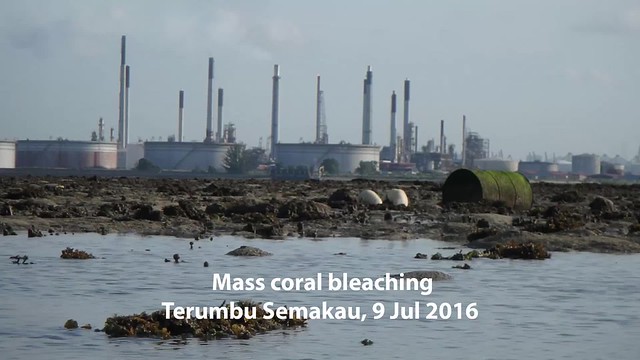We estimate about 50% of the hard corals and 50% of the leathery soft corals are bleaching. We estimate 20% of the corals have died recently.
Terumbu Semakau lies next to the Semakau Landfill and close to the petrochemical plants on Pulau Bukom. Yet, it remains one of the nicest submerged reefs in Singapore.
From Terumbu Raya, we could also see mass coral bleaching on the eastern shore of Pulau Semakau, just across the narrow (but deep channel).
Here's a video clip of the mass coral bleaching on Terumbu Semakau.
Mass coral bleaching in Singapore is not unexpected. From the NOAA's coral reef watch satellite monitoring, Singapore is in the yellow Watch zone. Where we should be prepared for mass coral bleaching.

What is coral bleaching?
Coral are colonies of tiny animals called polyps. Each polyp lives inside a little hard skeleton. The huge colony is made up of the skeletons of countless polyps. The polyps of all reef-building hard corals harbour microscopic, single-celled algae (called zooxanthellae). The polyp provides the zooxanthellae with shelter and minerals. The zooxanthellae carry out photosynthesis inside the polyp and share the food produced with the polyp. Corals generally have white colour skeletons, which is believed to assist in photosynthesis by reflecting light onto the zooxanthellae.
 |
| Large coral not bleaching, with the Semakau Landfill and transfer station on the horizon. |
 |
| Bleaching corals on the rich reefy western shore of Terumbu Semakau. |
 |
| These Branching montipora corals were not bleaching. |
 |
| About 50% of the leathery soft corals were not bleaching. Shore facing the Semakau Landfill. |
The corals that were not bleaching were dead.
In fact, we noticed a lot of recently dead corals and corals with dead patches. These include corals that were not bleaching and those that were still bleaching. We estimate about 20% of corals died recently.
It was nice to see a few Cauliflower corals were not bleaching, and that most of the Sandpaper corals were not bleaching. But many had dead patches.
It was also nice to see some Asparagus flowery soft corals that were not bleaching. And 50% of the leathery soft corals were alright. Although many had dying portions covered in growths.
Today I saw two Merten's carpet anemones. They were not bleaching! We also saw many many Magnificent anemones and many Giant carpet anemones. None of them were bleaching. There were a few Frilly sea anemones, some bleaching, and two Fire anemones, one bleaching, one not.
Other special finds by the team include a Fluted giant clam that was not bleaching.
There used to be lush seagrass meadows on Terumbu Semakau. Here's what the seagrass meadows looked like when we visited inJune 2010.
Today I sense the seagrasses are back but heavily covered in growths (epiphytes). On our last survey here in Dec 2015, I saw mostly vast areas of bare sand with sprinkles of seagrasses.
There were large expanses covered in Spoon seagrass, with patches of Serrated ribbon seagrass, and many clumps of cropped Tape seagrasses (about 10-20cm long). Hopefully, this means a slow recovery of the seagrass meadows on Terumbu Semakau?
I saw this drum on the shore. It was corroded and no longer contained any chemicals. There were a few abandoned fish traps and the team found a fishing net.
While there is not much we can do when our corals start bleaching, we can do a lot to stop other stresses that impact our reefs so the corals are in better health and don't succumb after bleaching.
High res photos of mass coral bleaching in Singapore for free download on wildsingapore flickr
Posts by others on this trip
- Dayna on facebook.
- Lisa Lim on facebook.
- Loh Kok Sheng on his blog and facebook.
Others on this trip: Toh Chay Hoon, Nicholas Yap, Geraldine Lee, Adriane Lee














